Foreign Insulators
by Marilyn Albers
Reprinted from "Crown Jewels of the Wire", December 1993, page 28
FOREIGN INSULATORS AND THEIR GO-WITHS
Part II - "Insulators that share
a trademark with
other products of the manufacturer"
Several years ago, as I found myself leaning toward a specialty in foreign
insulators, I began to pick up a small item here and there, such as an ash tray
or a bottle, that bore the same trademark as I had noticed on one of the
insulators in my collection. This was fascinating to me, but as I have learned
since, it is not at all unusual. Many large companies are so diversified that
they are able to produce insulators at one factory, dinnerware at a second
plant, and bathtubs, sinks and commodes at a third location. Unfortunately (or
rather,
fortunately) some of these items are impossible to incorporate into an insulator
collection! That's okay because we really didn't want to move out of our
house, but even so, the many "Go-Withs" I have accumulated are quite
a collection in themselves. I share with you some of my favorites alongside
their "pin pals". Some of the manufacturers' names have changed either
due to company mergers or to the fact that they are no longer in business.
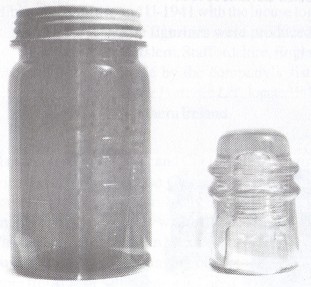 |
Amber fruit jar and CD 121, embossed AGEE, the trademark of Australian Glass
Manufacturers in Sydney. |
|

|
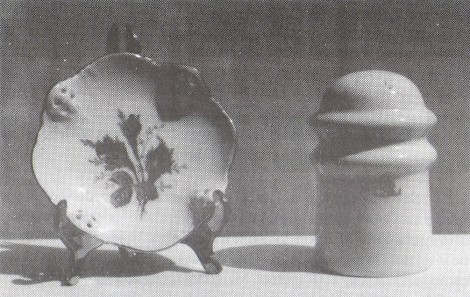
Decorative pin tray and U-1181, each made by a different subsidiary of the
large German corporation known since 1974 as Rosenthal Technik GmbH. Both pieces
carry the same trademark. The particular division called Rosenthal Isolatoren,
which was responsible for producing the insulator, is located in Selb, (State
of) Bavaria, Germany. The pin tray was made by one of the other Rosenthal
subsidiaries. In 1985, Rosenthal Technik changed its name to Hoechst CeramTec
AG.

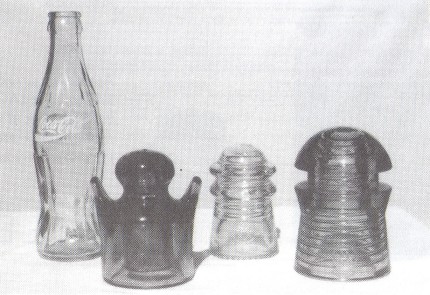
Coke bottle and (L to R) CD's 640, 106, and 408, all bearing
the 'VM' trademark of Cartel Vidriera Monterrey in Mexico. The bottle is dated
1986, indicating that the Coca Cola Company subcontracted the production of its
soft drink bottles to this Mexican glass factory. Vidriera Monterrey also
produced insulators for local use (CD 106), as well as for export to France (CD
640), Romania (CD 408), and perhaps to other countries.


Miniature figurines and U-1941 with the incuse logo of Wade Potteries Ltd.
The figurines were produced by the main factory in Burslem, Staffordshire,
England and the insulator was made by the company's sister firm, also known as
Wade Potteries Ltd., located in Portadown, Co. Armagh, Northern Ireland.


Hand-blown glass pitcher and CD 107, both embossed with
the trademark of the Crisa Corporation. These pieces were made somewhere in
Mexico, probably Monterrey, but I was unable to find out exactly where the
factory is located. The insulator was found in Mexico, but the pitcher was
purchased in Houston, having come to a department store from Crisa' s
distributor in Laredo, Texas.

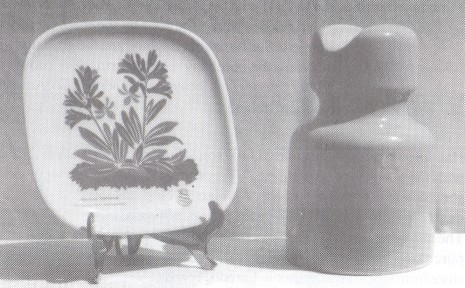
Pin tray with red flowers and U-1745 with yellow glaze, each with the incuse
mark of Porzellanfabrik Suisse Langenthal, in Langenthal,
Switzerland. This factory has the necessary facilities to produce
dinnerware, decorative porcelain and insulators all under the same roof.


Advertising ashtray and CD 575 embossed L' ELECTRO VERRE, for the name of the
manufacturer, located in Saint-Yorre, Allier, France. In 1959, this company
became part of the large French firm, which is known today as Sediver.


Ceramic animals and U-1741 bearing the ink stamp of Zsolnay Ceramics of
Pecs,
which is the largest company of its kind in Hungary. Many types of ceramics are
produced at this factory.


Glass advertising tray and CD 343.2, found in Australia but made by
Pilkington Brothers Ltd. of St. Helens, England. These were probably supplied by
the Pilkington distributor located in Sydney. As you can see, the tray is
stamped with the Pilkington name, but the insulator is unembossed, so we will
just say that these two pieces shared the same manufacturer.
This last item has no "pin pal", but I think it is unique and
deserves mention. The Zulus of South Africa have created this beautiful basket
by weaving telephone wire into a pattern of many colors. The baskets, which come
in several sizes, are being imported to the United States and sold through a
gift shop here.
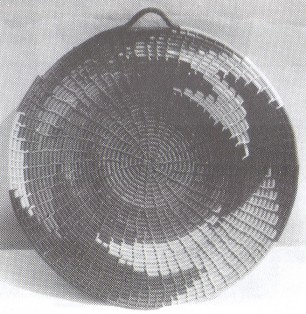
|
